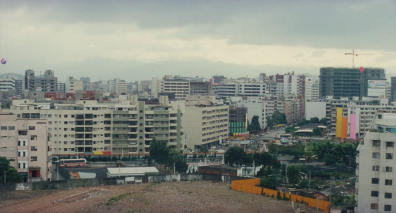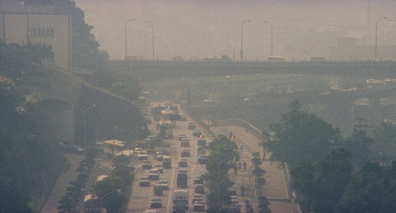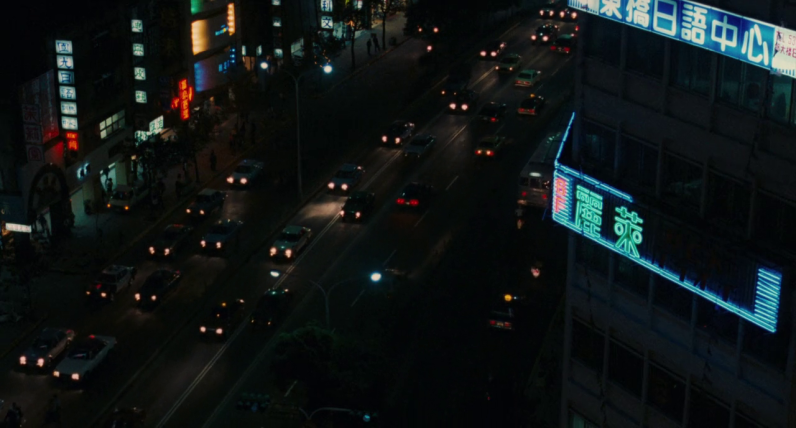I have been looking for a new apartment, a task which has consumed a massive amount of my time and distracted me from other pursuits, like watching movies and writing reviews for Criterion Month. After spending a whole day walking around and viewing apartments, I sat down to watch Taipei Story. The film begins with Chin (Tsai Chin) and Lung (Hou Hsiao-hsien) walking around and viewing apartments. This is a familiar feeling for a cinephile, something I often experience during film festivals; sometimes, I’m not sure where my life ends and movies begin. And it’s not surprising when it comes to the cinema of Edward Yang, whose novel-like dramas unfold with such steady, hypnotic rhythm that they seem to bleed into my surroundings. After a screening of Yang’s recently restored 1986 film, The Terrorizers, I remarked to a friend that I could have sat and spent the rest of my day watching it. Once you’re grooving to a good film, you never want it to end. And once you’re grooving on Yang’s wavelength, you’re just living.
Taipei Story is not as expansive in scope as The Terrorizers, but they share many aesthetic qualities. More than anything, they demonstrate Yang’s keen sense for how to balance multiple characters and plot threads, how and when to cut from one piece to another. The mood in Taipei Story is perfectly modulated from moment to moment, all the more impressive given that it’s only Yang’s sophomore film. The editing expertly captures the ebb and flow of urban life, tracing the characters through winding streets and neon lit buildings, while exploring their emotional and psychological states through their varied interpersonal interactions. It’s a cliché to compare Yang’s films to a novel, perhaps, but he truly earns that description.
Throughout the film, we follow Chin and Lung as their relationship slowly disintegrates. Yang, who co-wrote the script with Hou Hsiao-hsien and Chu T’ien-wen, sends his two principal characters down different paths, holding their fractured relationship up as a mirror to a city rapidly transforming under the force of globalization. Chin and Lung illustrate an urban listlessness that is both specific to Taipei at that point in time and more broadly applicable to the changing economic realities we continue to face in today’s global village.
The specific politics of Yang’s film are detailed in Andrew Chan’s Criterion essay, “Taipei Story: Modern Planning.” The subplot involving Lung lending money to Chin’s father, and subsequently dashing or at least complicating and delaying his own plans for moving to California, is a reaction to Chinese culture and tradition. As per Chan,
“For all the alienation and cultural rootlessness found in Yang’s vision of modernity, this depiction of a society shackled to age-old habits of filial piety signals the director’s unwillingness to romanticize a Confucian past littered with its own skeletons. […] [A]nd while China is hardly mentioned, Yang’s argument against the presumption of inherent value in old ties could be interpreted as a subliminal refutation of the mainland’s historical claims to sovereignty over Taiwan.”
It is also a reaction to Taipei’s economic fortunes at the time, or perhaps a warning about the direction in which Taipei found itself moving; Chan notes that Yang was “resigned neither to the reassurances of tradition nor to the enticements of modernity” and that “Yang’s cynical appraisal of a proudly cosmopolitan city must have been hard to stomach for many Taiwanese of the period.” Taipei Story is explicitly a movie of its time, placed directly in dialogue with a city undergoing massive change; Yang’s consideration of Taipei in a global economic landscape, however, gives the film an enduring strength with broader appeal.
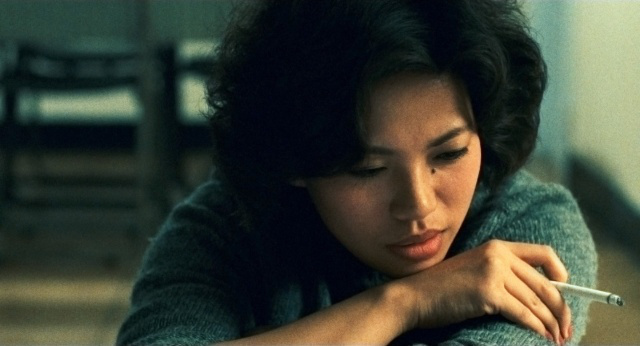
Yang’s analysis of Taipei is philosophical as well as political; by considering the global realities of modernity and situating Taipei within it, Yang adds another dimension to the film by contextualizing the politics of the day with a dose of existentialism. Much of the film’s drama, including the troubled relationship at the center of the story, is driven by the need to belong, and the difficulty of “belonging” to a world that is rapidly evolving, unstable, and in the process of unprecedented upheaval. Lung is often characterized as someone clinging to the past, to the former glory of his baseball career, and while true in a sense, his journey is more about an existential dislocation from the place he calls “home,” i.e. Taipei. The movie begins with him returning from California, where his family now resides. When asked how Los Angeles compares to Taipei, Lung merely replies that they’re similar. He does not fully believe this, as he reveals in a later scene, but it is the first indication that Lung’s concept of “home” has been pulled apart in various directions.
More obviously, Lung stops in Tokyo on his return trip to visit his ex, Gwan (Ko Su-Yun), a fact he hides from Chin. Gwan eventually appears in the film during a brief visit to Taipei. Lung and Gwan meet and walk through a playground, discussing their history together. Gwan swings on a swing set. Lung is mostly silent. There are memories in this park, of friends and family, of lives lived. Lung and Gwan return here to reconnect to a home they once had, and can no longer have again. They care for each other, or the ideas that they represent for each other, but there is no longer a clear sense of belonging. Gwan lives in Tokyo now, with her husband Kobayashi. Before they leave, she asks Lung when he will visit Tokyo again. He is silent for a brief moment, and the scene simply ends. More than just clinging to former glory, Lung clings to people he cares about, or once cared about, family and former flames alike, who have been scattered across the globe; he desperately clings to a concept of home that globalization has ruptured, and that he is aware he can no longer possess.
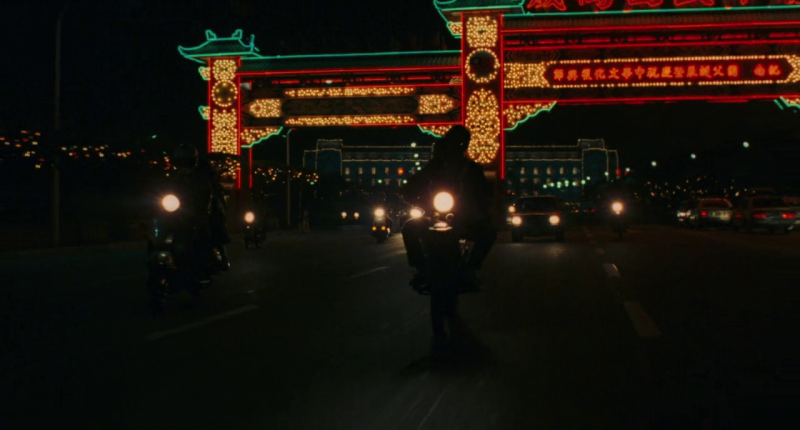
Chin similarly drifts between Lung and a former co-worker, holding on to fragments of relationships, scared to let go. One of the strengths of Yang’s dense layering of character and plot is that each and every part, however small, finds its own way to contribute something meaningful to a larger understanding of the whole. Gwan’s role provides a metaphor for a changing global landscape (her home is now somewhere between Taipei and Tokyo), and Chin’s co-worker, an architect, also gets an important scene illustrating one of the film’s key existential themes. He laments that buildings in Taipei are all beginning to look the same, and that he can no longer tell which ones he designed. “Whether I’m involved or not,” he says, “seems less and less important.” This is the uncomfortable reality of a rapidly evolving global modernity, the diminishing sense of belonging. Chin’s co-worker senses that he could remove himself from the equation and nothing about Taipei would change.
Yang also demonstrates these themes through his visuals. As Chin and her co-worker walk and talk about the concept of fate, Yang tracks them in a wide shot, two figures moving through an enormous architectural space, twice disappearing from sight. The massive structures of a modern Taipei seem to diminish, if not consume, the people in them.
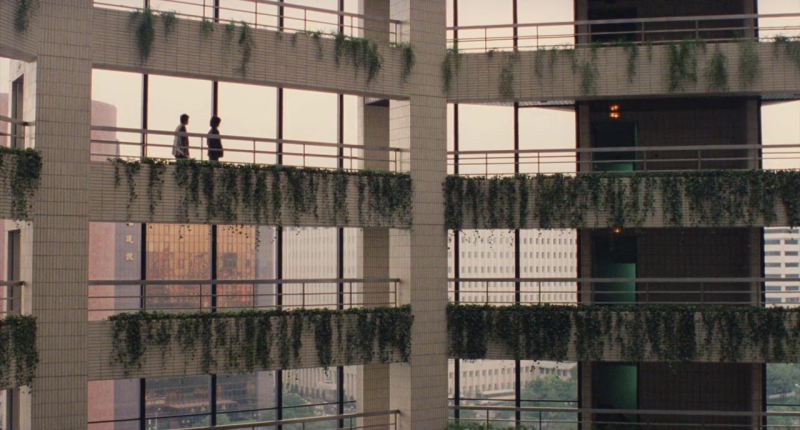
Yang captures the scale of the city in a series of wide shots that emphasize the urban environment over the people in it, reducing pedestrians and automobiles to anonymous crowds.
Most pointedly, the films ends with an image of a building that distorts the reflections of automobiles and other buildings around it. This image is the culmination of the film’s drama, politics, and aesthetics, the anonymous building of a faceless urban sprawl, twisting and distorting the reality of Taipei, fracturing the people who live there.
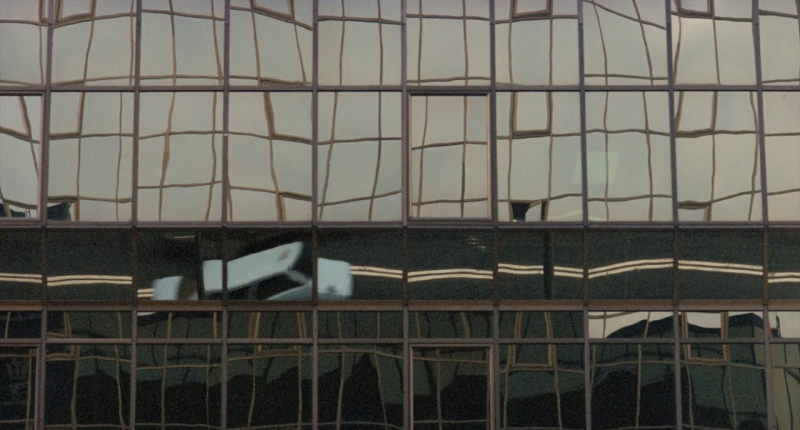
While I was viewing apartments, everything started bleeding together. Each place started looking like the previous, and the next; my realtor commented that once you’ve seen one unit you’ve seen them all. Standing in a condo, looking out over the Toronto skyline, I felt like Chin’s co-worker. I began to doubt my plans, and my place in the city. I felt small and insignificant. It’s a familiar feeling in a massive urban area. And only hours later, I would watch an Edward Yang film and have those feelings thrown back at me again. That’s the power of Yang’s work; even a brief scene with a minor character can take up residence in your mind and expand in surprising ways. Yang explores the forces of modernity that were shaping Taipei in an increasingly globalized world, and the existential conditions he captures echo through space and time. Taipei Story was released in 1985, and reacts to a specific place and time, but over thirty years later, in different parts of the world, it feels no less relevant, vital, and immediate. And that’s the most impressive effect of Yang’s art: the immediacy of the experience, the way it captures the ebb and flow of life in the rhythm of the editing; the frame itself washes away, and all that remains is a feeling of presence, of living and breathing.

